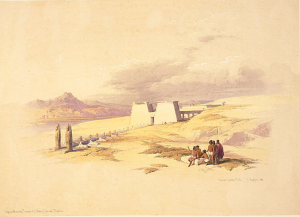Willeke Wendrich and Rosa Tamborrino
The conservation of tangible cultural heritage, be it objects or buildings, is strongly focused on materials and their treatment. Even with the increased interest in intangible cultural heritage and the new understandings it has fostered in conservation, attention to the intangible aspects of archaeological objects and monuments is still far from widespread. Digital Nubia: Cultural Heritage in Context is a collaboration between the University of California, Los Angeles, USA (UCLA) and the Politecnico di Torino, Italy (POLITO) centered on the study of the Nubian temples rescued in a large United Nations Educational, Scientific and Cultural Organization (UNESCO) effort in the 1960s.  This project aims to take a multi-faceted approach to the digital modeling of the drowned cultural landscape of Egyptian Nubia with the model serving as the platform on which information on the history, research, and methods of preservation of both tangible and intangible aspects of Nubian heritage are documented and shared. The proposed platform not only will visualize aspects of the lost Nubian landscape but will provide a means to incorporate elements of its tangible and intangible heritage. It will be designed as a resource for further research, as well as a carrier of multi-vocal narratives. The contributions by academics will be linked to information from museums, interviews with archaeologists who worked in the region in the 1960s, memories of the Nubian population as well as ephemera and documents from the recent past, such as the letters written in protest of the resettlement of the Nubians.
This project aims to take a multi-faceted approach to the digital modeling of the drowned cultural landscape of Egyptian Nubia with the model serving as the platform on which information on the history, research, and methods of preservation of both tangible and intangible aspects of Nubian heritage are documented and shared. The proposed platform not only will visualize aspects of the lost Nubian landscape but will provide a means to incorporate elements of its tangible and intangible heritage. It will be designed as a resource for further research, as well as a carrier of multi-vocal narratives. The contributions by academics will be linked to information from museums, interviews with archaeologists who worked in the region in the 1960s, memories of the Nubian population as well as ephemera and documents from the recent past, such as the letters written in protest of the resettlement of the Nubians.
This project is not only relevant in the light of the construction of two dams on the Egyptian side of the Nile-the first, the Aswan Low Dam, was built between 1898 and 1902 and the second, the Aswan High Dam, between 1960 and 1970-but also in relation to the ongoing threat to the region from current plans for the damming of the Nile in Sudan and Ethiopia.